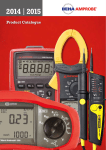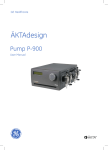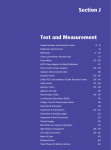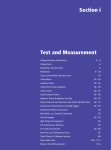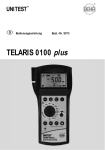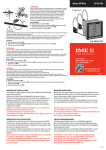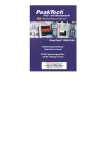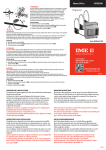Download UNITEST®
Transcript
PTDB2054-02.qxd 20.09.2005 9:05 Uhr ® UNITEST ® Bedienungsanleitung Instruction Manual Istruzioni per l'uso Voltfix - Drill Seite 1 PTDB2054-02.qxd 20.09.2005 9:05 Uhr Symbolerklärung Warnung vor einer Gefahrenstelle. Bedienungsanleitung beachten. Vorsicht! Gefährliche Spannung, Gefahr des elektrischen Schlages. Durchgängige doppelte oder verstärkte Isolierung entsprechend Schutzklasse II IEC 61140. Kennzeichnung elektrischer und elektronischer Geräte (WEEE Richtlinie 2002/96/EG). Konformitätszeichen, bestätigt die Einhaltung der gültigen Richtlinien. Die EMVRichtlinie (89/336/EWG) werden eingehalten. Die Niederspannungsrichtlinie (73/23/ EWG) wird ebenfalls eingehalten. Einleitung: Der Spannungsprüfer UNITEST Voltfix Drill ist eine Weiterentwicklung der bewährten VoltfingerBaureihe und ermöglicht dem Anwender neben der indirekten Spannungsprüfung an isolierten Kabeln auch die direkte Spannungserkennung über Metallspitze und Berührungselektrode. Weiterhin ist ein Durchgangsprüfer eingebaut. 2 Seite 2 PTDB2054-02.qxd 20.09.2005 9:05 Uhr Leistungsmerkmale: • Berührungslose Spannungsprüfung 50 V ... 600 V AC. • Direkte Spannungsprüfung über Metallspitze u. Berührungselektrode von 50 V...600 V AC. • Einfache Durchgangsprüferfunktion. • Auffinden von Leitungsunterbrechungen in isolierten Kabel und Leitungen. • Phasenprüfer an Steckdosen. • Anzeige mittels Leuchtdiode (blinkend) und akustisches Tonsignal (pulsierend). • Integrierte Taschenlampe. • Automatischer Eigentest bei Inbetriebnahme. • Kompakte handliche Bauform. Sicherheitsmaßnahmen Das Gerät hat unser Werk in sicherheitstechnisch einwandfreiem Zustand verlassen. Um diesen Zustand zu erhalten, muß der Anwender die Sicherheitshinweise in dieser Anleitung beachten. Achtung! Die Bedienungsanleitung enthält Informationen und Hinweise, die zu einer sicheren Bedienung und Nutzung des Gerätes notwendig sind. Vor der Verwendung des Gerätes ist die Bedienungsanleitung aufmerksam zu lesen und in allen Punkten zu verstehen und zu befolgen. Wird die Anleitung nicht beachtet oder sollten Sie es versäumen, die Warnungen und Hinweise zu beachten, können ernste oder lebensgefährliche Verletzungen bzw. Beschädigungen des Gerätes eintreten. 3 Seite 3 PTDB2054-02.qxd 20.09.2005 9:05 Uhr Achtung! Bei Spannungsmessungen jeder Art darf das Gerät nur am Handgriff angefaßt werden. Achtung! Eine einwandfreie Funktion ist nur innerhalb dem in den technischen Daten angegebenen Temperaturbereich gewährleistet. Achtung! Vor jeder Benutzung muß das Gerät auf einwandfreie Funktion (z.B. an einer bekannten Stromquelle) geprüft werden. Vorsicht! Vor dem Öffnen (z.B. für Batteriewechsel) muß das Gerät von allen Stromkreisen getrennt werden. Achtung! Das Gerät darf von unbefugten Personen nicht geöffnet oder zerlegt werden. Achtung! Bestimmungsgemäße Verwendung: Das Gerät darf nur unter den Bedingungen und für die Zwecke eingesetzt werden, für die es konstruiert wurde. Hierzu sind besonders die Sicherheitshinweise, die Technischen Daten mit den Umgebungsbedingungen und die Verwendung in trockener Umgebung zu beachten. 4 Seite 4 PTDB2054-02.qxd 20.09.2005 9:05 Uhr Anzeige und Bedienelemente: 1) Metallprüfspitze (Schraubendreherspitze) 2) LED für Spannungsanzeige 3) Batteriefachdeckel und Lampe für Spannungsanzeige und Taschenlampenfunktion 4) Schiebeschalter (3 Positionen) mit Klipp 5) Berührungselektrode Der Schalter (4) hat drei Positionen: Schalterstellung Messprinzip Pos. 1 indirekt (kontaktlos) Pos. 2 indirekt (kontaktlos) Pos. 3 Direkt (Metallspitze und Berührungselektrode) 5 Seite 5 PTDB2054-02.qxd 20.09.2005 9:05 Uhr Durchführen von Wechselspannungsprüfungen: Vorsicht! Um einen elektrischen Schlag zu vermeiden, sind unbedingt die geltenden Sicherheits- und VDEBestimmungen bezüglich zu hoher Berührungsspannung zu beachten, wenn mit Spannungen größer 120 V (60 V) oder 50 V (25 V) eff AC gearbeitet wird. Die Werte in Klammern gelten für eingeschränkte Bereiche (wie z.B. Medizin, Landwirtschaft). Achtung! Der Spannungsprüfer ist für Wechselspannungen zwischen 50 V und 600 V konstruiert. Eine einwandfreie Funktion ist nur im Temperaturbereich von 0...40°C <80% Feuchte gewährleistet. Achtung! Das Gerät darf nicht zum Feststellen der Spannungsfreiheit in elektrischen Anlagen eingesetzt werden. Bei abgeschirmten Leitungen oder Geräten ist eine indirekte Spannungsprüfung (kontaktlos) nicht oder nur eingeschränkt möglich. Berührungslose (indirekte) Spannungsprüfungen Diese Messart ist in den Schalterstellungen Pos.1 + 2 möglich und beinhaltet die kontaktlose Spannungserkennung von isolierten Kabel, Leitung oder Geräten die ein elektromagnetisches Feld aussenden. Weiterhin können hiermit auch Unterbrechungen in Kabeln erkannt werden. Bei der Prüfung von Netzanschlußkabel auf Unterbrechung ist zu beachten, daß beide Leitungen einmal an die Phase (L) angeschlossen werden (Schukostecker um 180° drehen). 6 Seite 6 PTDB2054-02.qxd 20.09.2005 9:05 Uhr Direkte Spannungserkennung (Kontakt über Metallspitze und Berührungselektrode) Im Gegensatz zur berührungslosen Spannungserkennung erfolgt unter Pos.3 die direkte Spannungsprüfung an der leitenden Oberfläche des Messobjektes. Hierzu muss die Metallspitze auf den Messpunkt aufgesetzt werden und der Anwender muss die Berührungselektrode kontaktieren. Schalter- Messprinzip Funktionen stellung Pos. 1 Pos. 2 Pos. 3 Kontaktlose Indirekt (kontaktlos) Spannungserkennung LED blinkt und Signal ertönt! Taschenlampe ist eingeschaltet. Kontaktlose Indirekt (kontaktlos) Spannungserkennung LED blinkt, Signal ertönt und Taschenlampe blinkt Direkt (Metallspitze und Berührungsel ektrode Kontaktbezogene Spannungsprüfung LED blinkt Signal ertönt und Taschenlampe blinkt Durchgangsprüferfunktion ist aktiv (Messobjekt muß spannungsfrei sein) 7 Seite 7 PTDB2054-02.qxd 20.09.2005 9:05 Uhr Anwendungsbeispiele "Indirekte Spannungsprüfung": Spannungsprüfung ohne abisolieren Auffinden von Leitungsunterbrechung z.B. Kabeltrommel usw. Anwendungsbeispiele " Direkte Spannungsprüfung": Phasenfinder an Steck- und Abzweigdosen Spannungsprüfung an Sicherungsautomaten Durchgangsprüferfunktion In der Schalterstellung Pos.3 ist eine einfache 8 Seite 8 PTDB2054-02.qxd 20.09.2005 9:05 Uhr Durchgangsprüferfunktion integriert (Metallspitze - Messobjekt - Anwender - Berührungselektrode). Hiermit lassen sich zum Beispiel Sicherungen, Lampen, Leitungen usw. auf Durchgang prüfen. Durchgangsprüfung bei Sicherungen Wartung: Das Gerät benötigt bei einem Betrieb gemäß der Bedienungsanleitung keine besondere Wartung. Reinigung Sollte das Gerät durch den täglichen Gebrauch schmutzig geworden sein, kann das Gerät mit einem feuchten Tuch und etwas milden Haushaltsreiniger gereinigt werden. Verwenden Sie niemals scharfe Reiniger oder Lösungsmittel. Batteriewechsel 1) Schalterstellung auf Pos.1 stellen und die Batteriekappe (3) mit einem Schraubendreher o.ä. öffnen 9 Seite 9 PTDB2054-02.qxd 20.09.2005 9:05 Uhr 2) Die alten Batterien durch neue ersetzen, dabei Polarität beachten! Batterietyp siehe techn.Daten. 3) Batteriekappe vorsichtig aufdrücken bis zur Einrastung. Batteriedeckel schließen Achtung! Wird das Gerät über einen längeren Zeitraum nicht benutzt, muß die Batterie entnommen werden. Sollte es zu einer Verunreinigung des Gerätes durch ausgelaufene Batterien gekommen sein, muß das Gerät zur Reinigung und Überprüfung ins Werk eingesandt werden. Bitte denken Sie an dieser Stelle auch an unsere Umwelt. Werfen Sie verbrauchte Batterien nicht in den normalen Hausmüll, sondern geben Sie die Batterien bei Sondermülldeponien ab. Achtung! Es müssen die jeweils gültigen Bestimmungen bzgl. der Rücknahme, Verwertung und Beseitigung von gebrauchten Batterien und Akkumulatoren beachtet werden. 10 Seite 10 PTDB2054-02.qxd 20.09.2005 9:05 Uhr Technische Daten (gültig für 23°C ±5°C, < 80% rel. Luftfeuchte) Spannungsbereich: Frequenzbereich: Durchgangstest: Anzeige: Schutzart: Temperaturbereich: 50 V...600 V AC 50 Hz...500 Hz 0...3 MΩ Optisch mit blinkender LED / Lampe und Signalton pulsierend IP 40 0°C...40°C < 80% Feuchte Überspannungskategorie: CAT III / 600 V gegen Erde Verschmutzungsgrad: 2 Meereshöhe: bis 2000 m Stromversorgung: 2 x 1,5 V Batterien (Micro) IEC LR03 Maße: 160 x 25 x 21 mm Gewicht: ca. 55 g 11 Seite 11 PTDB2054-02.qxd 20.09.2005 9:05 Uhr 24 Monate Garantie Die Geräte unterliegen einer strengen Qualitätskontrolle. Sollten während der täglichen Praxis dennoch Fehler in der Funktion auftreten, gewähren wir eine Garantie von 24 Monaten (nur gültig mit Rechnung). Fabrikations- oder Materialfehler werden von uns kostenlos beseitigt sofern das Gerät ohne Fremdeinwirkung und ungeöffnet an uns zurückgesandt wird. Beschädigungen durch Sturz oder falsche Handhabung sind vom Garantieanspruch ausgeschlossen. Treten nach Ablauf der Garantiezeit Funktionsfehler auf, wird unser Werksservice Ihr Gerät unverzüglich wieder instandsetzen. Diese Bedienungsanleitung wurde mit großer Sorgfalt erstellt. Für die Richtigkeit und Vollständigkeit der Daten, Abbildungen und Zeichnungen wird keine Gewähr übernommen. 12 Seite 12 PTDB2054-02.qxd 20.09.2005 9:05 Uhr ® UNITEST ® Instruction Manual Istruzioni per l'uso Voltfix - Drill Seite 13 PTDB2054-02.qxd 20.09.2005 9:05 Uhr References marked on instrument or in instruction manual: Warning of a potential danger, comply with instruction manual. Caution! Dangerous voltage. Danger of electrical shock. Continuous double or reinforced insulation complies with category II IEC 61140. Symbol for the marking of electrical and electronic equipment (WEEE Directive 2002/96/EC). Conformity symbol, the instrument complies with the valid directives. It complies with the EMV Directive (89/336/EEC), are fulfilled. It also complies with the Low Voltage Directive (73/23/EEC) is fulfilled. Introduction The voltage tester UNITEST Voltfix Drill is a further development of the proven Voltfinger series. This instrument allows the user the direct voltage detection via metal probe and contact electrode besides the indirect voltage test on insulated cables. The Voltfinger is equipped with the conventional continuity tester. 14 Seite 14 PTDB2054-02.qxd 20.09.2005 9:05 Uhr Features: • Contact-free voltage test 50 V...600 V AC • Direct voltage testing via metal probe and contact electrode from 50 V... 600 V • Easy continuity test. • Locating line interruptions in insulated cables and conductors • Phase tester of sockets • Display via LED (blinking) and acoustical signal (pulsing). • Torch function • Automatic self test • Compact and handy Safety Measures The instrument has left our factory in a safe and perfect condition. To maintain this condition, the user must pay attention to the safety references contained in this instruction manual. The instruction manual contains information and references, necessary for safe operation and maintenance of the instrument. Prior to using the instrument the user is kindly requested to thoroughly read the instruction manual and comply with it in all sections. Failure to read the instruction manual or to comply with the warnings and references contained herein can result in serious personal injury or damage to instrument. 15 Seite 15 PTDB2054-02.qxd 20.09.2005 9:05 Uhr Only touch the instrument at handle surface provided. The instrument may only be used within the operating ranges specified in the technical data section. Before batteries are replaced the instrument must be disconnected from all live circuits. The instrument may only be opened by professionals. Appropriate Usage The instrument may only be used under those conditions and for those purposes for which it was developed. For this reason, particular attention must be paid to and instructions must be followed regarding the safety references the technical data - including environmental conditions and, usage in dry environments. If the instrument is modified or changed in any way its operational safety is no longer guaranteed. 16 Seite 16 PTDB2054-02.qxd 20.09.2005 9:05 Uhr Display and Operation Elements 1) Metal test probe (screw driver probe) 2) LED for voltage indication 3) Battery case and lamp for voltage display and torch function 4) Slide switch (3 positions) with clip 5) Contact electrode The switch (4) has three positions Switch position Measurement Principal Pos. 1 indirect contactless Pos. 2 indirect contactless Pos. 3 direct (metal probe and contact electrode) 17 Seite 17 PTDB2054-02.qxd 20.09.2005 9:05 Uhr Carrying out voltage measurement AC In order to avoid electrical shock, the valid safety and VDE regulations regarding excessive contact voltages must receive utmost attention, when working with voltages exceeding 120 V (60 V) DC or 50 V (25 V)rms AC. The values in brackets are valid for limited ranges e.g., medicine and agriculture). Attention The voltage tester is appropriate for AC voltages between 50 V and 600 V AC. A perfect instrument function is only ensured within a temperature range of 0 ... 40°C, <80 % humidity. Attention The instrument may not be used to prove the absence of voltage in electrical systems. When working with sheathed conductors or instrument, the indirect voltage test (contact-free) is either impossible or only feasible considering certain restrictions. Contactless (indirect) voltage testing This kind of measurement is possible with switch pos. 1 + 2 and covers contactless voltage detection of insulated cables, leads or instruments which send electric magnetic fields. In addition cable interruptions can be detected. When testing mains connecting cables for interruptions the user must ensure that both lines are connected to phase (L). (Turn plugs by 180°). 18 Seite 18 PTDB2054-02.qxd 20.09.2005 9:05 Uhr Direct voltage indication (Contact via metal probe and contact electrode) Direct voltage testing on the conducting UUT surface can be carried out by selecting position 3 (different to contact-free voltage detection). For this purpose, place the metal probe onto the measurement spot whilst touching the contact electrode. Switch- Measuring Position Principal Function Position Pos. 1 Indirect Contactless voltage (contactless) detection LED is blinking and signal is audible! Torch function is active Pos. 2 Contactless voltage Indirect (contactless) detection LED is blinking and signal is audible! Torch function is blinking Pos. 3 Direct Contacting voltage (metal probe testing and Contact LED is blinking signal is audible. Torch function is electrode) blinking. Continuity is active (UUT must be voltage free) 19 Seite 19 PTDB2054-02.qxd 20.09.2005 9:05 Uhr Working example "Indirect voltage testing": Voltage test at Insulated conductors Locating line interruption l.e. cable drums etc. Working example " Direct voltage testing": Phase finding on socket aoutlets Voltage measurement at automatic circuit breaker Continuity testing A simple continuity tester function is integrated position 3 (metal probe – UUT – user – contact electrode). This function is used to test e.g. fuses, 20 Seite 20 PTDB2054-02.qxd 20.09.2005 9:05 Uhr lamps, conductors, etc. for continuity. Continuity test at fuses Maintenance When using the instrument in compliance with the instruction manual, no special maintenance is required. Cleaning If the instrument is dirty after daily use, it is advised that it be cleaned using a damp cloth and a mild household detergent. Never use acid detergents or solvents for cleaning. Battery replacement 1) Set the switch to position 1, press and push lightly to open. 2) Remove discharged batteries and insert new ones while respecting correct polarity. For bat21 Seite 21 PTDB2054-02.qxd 20.09.2005 9:05 Uhr tery type, please refer to the technical data section. 3) Carefully press battery case cover until latching. Close battery cover If an instrument is not being used over an extended period of time, the batteries should be removed. If the instrument is contaminated by leaking batteries, the instrument should be returned to the factory for cleaning and inspection. Please consider your environment when you dispose of your batteries. They belong in a rubbish dump for hazardous waste. In most cases, the batteries can be returned to their point of sale. Please, comply with the current regulations concerning the return, recycling and disposal of used batteries. 22 Seite 22 PTDB2054-02.qxd 20.09.2005 9:05 Uhr Technical Data (for 23°C ±5°C, < 80% rel. humidity) Voltage range: Frequency range: Continuity test: Display: 50 V...600 V AC 50 Hz...500 Hz 0...3 MΩ Clear, omnidirectional flashing beacon IP-Protection: IP 40 Temperature range: 0°C up to 40°C Overvoltage category: CAT III, 600 V against ground Pollution degree: 2 Altitude: up to 2000 m Power supply: 2 x 1,5 V Batterien (Micro) IEC LR03 Dimensions: 160 x 25 x 21 mm Weight: approx. 55 g 23 Seite 23 PTDB2054-02.qxd 20.09.2005 9:05 Uhr 24 Month Guarantee: The instruments are subject to stringent quality controls. If, in the course of normal use, a fault should occur, it is covered by our 24 Month Guarantee (valid only with invoice). Faults in manufacture and materials will be rectified by us free of charge, provided the instrument has not been tampered with, and is returned to us unopened. Damage due to dropping, abuse or misuse is not covered by the guarantee. Our Service Department will promptly repair any faults that occur outside the guarantee period for a reasonable charge. This Instruction Manual has been prepared with great care. No liability is accepted for the correctness and completeness of the data, illustrations, and drawings it contains. We reserve the right to make technical alterations without notice. 24 Seite 24 PTDB2054-02.qxd 20.09.2005 9:05 Uhr ® UNITEST ® Istruzioni per l'uso Voltfix - Drill Seite 25 PTDB2054-02.qxd 20.09.2005 9:05 Uhr Descrizione dei simboli Avviso da punto di pericolo. Osservare le istruzioni d'uso. Prudenza! Tensione pericolosa, pericolo di folgorazione. Isolamento continuo doppio o rinforzato secondo classe di protezione II IEC 61140. Simbolo per la marcatura delle apparecchiature elettriche ed elettroniche (RAEE Direttiva 2002/96/EC). Marchio di conformità, conferma il rispetto delle direttive vigenti. La direttiva per la compatibilità elettromagnetica (89/336/CEE) vengono rispettate. La direttiva per basse tensioni (73/23/ CEE) viene rispettata anch'essa Introduzione: Il tester UNITEST Voltfix Drill è un'evoluzione dell'affermata serie Voltfinger e permette all'utilizzatore, oltre a controllare indirettamente la presenza di tensione su cavi isolati, anche il riconoscimento diretto di tensione tramite punta metallica ed elettrodo di contatto. Inoltre è montato un tester di passaggio corrente. 26 Seite 26 PTDB2054-02.qxd 20.09.2005 9:05 Uhr Caratteristiche: • Controllo tensione senza contatto 50 V ... 600 V AC. • Controllo diretto tensione tramite punta metallica ed elettrodo di contatto da 50 V...600 V AC. • Funzione semplice di controllo passaggio corrente. • Localizzazione di interruzioni conduttori in cavi e conduttori isolati. • Tester di fase per prese elettriche. • Indicazione tramite diodo luminoso (lampeggiante) e segnale acustico (ad impulsi). • Torcia integrata. • Autotest automatico all'accensione. • Esecuzione costruttiva compatta e maneggevole. Provvedimenti di sicurezza L'apparecchio è uscito dal nostro stabilimento in perfetto stato di funzionamento. Per mantenere tale stato, l'utilizzatore deve osservare le avvertenze di sicurezza contenute nelle presenti istruzioni. Le istruzioni d'uso contengono informazioni ed indicazioni necessarie per un comando ed un uso sicuro dell'apparecchio. Prima di usare l'apparecchio, leggere con premura le istruzioni d'uso e assicurarsi di averle comprese e di saperle rispettare. Se le istruzioni non vengono rispettate o se non vengono osservate le avvertenze e gli avvisi, possono venire causati infortuni seri o mortali o il danneggiamento dell'apparecchio. 27 Seite 27 PTDB2054-02.qxd 20.09.2005 9:05 Uhr Durante qualsiasi tipo di misurazione della tensione, l'apparecchio deve essere afferrato esclusivamente per l'impugnatura. Un funzionamento regolare è garantito esclusivamente entro il campo di temperatura indicato nei dati tecnici. Prima di ogni uso, l'apparecchio deve essere controllato verificando che esso funzioni regolarmente (p.e. applicandolo ad una fonte di corrente conosciuta). Prima di aprire l'apparecchio (p.e. per il cambio delle batterie) esso deve essere staccato da ogni circuito elettrico. L'apparecchio non deve essere né aperto né smontato da personale non autorizzato Uso consentito: L'apparecchio deve essere usato solo nelle condizioni e per gli scopi per i quali è stato costruito. A tale riguardo sono da osservare in particolar modo le avvertenze di sicurezza, i dati tecnici con le condizioni ambientali e l'uso in luoghi asciutti. 28 Seite 28 PTDB2054-02.qxd 20.09.2005 9:05 Uhr Display ed elementi di comando: 1) Punta di controllo metallica (punta giravite) 2) LED per l'indicazione della tensione 3) Coperchio del vano portabatterie e lampada per l'indicazione di tensione e funzione torcia 4) Interruttore scorrevole (3 posizioni) con clip 5) Elettrodo di contatto L'interruttore ha tre posizioni (4): Posizione dello interruttore Principio di misurazione Pos. 1 indiretto (senza contatto) Pos. 2 indiretto (senza contatto) Pos. 3 diretto (punta metallica e elettrodo d contatto) 29 Seite 29 PTDB2054-02.qxd 20.09.2005 9:05 Uhr Esecuzione di controlli di tensione alternata:: Prudenza! Se si lavora su tensioni maggiori di 120 V (60 V) o di 50 V ( 25 V) effettivi a corrente alternata, per evitare una folgorazione devono essere osservate assolutamente le disposizioni vigenti in materia di sicurezza e VDE riguardo ad alta tensione di contatto. I valori fra parentesi valgono per aree limitate (come p.e. nel campo della medicina, nell'agricoltura). Attenzione! Il tester è stato progettato per tensioni alternate comprese fra 50 V e 600 V. Un funzionamento regolare è garantito esclusivamente in un campo di temperatura compreso fra 0...40°C con umidità <80%. Attenzione! L'apparecchio non deve essere usato per constatare la mancanza di tensione in impianti elettrici. Nel caso di conduttori schermati o di apparecchi un controllo indiretto della tensione (senza contatto) non è possibile o lo è solo in parte. Controlli di tensione senza contatto (indiretti) Questo tipo di misurazione è possibile con l'interruttore in posizione 1 + 2 e contiene il riconoscimento senza contatto di tensione in cavi, conduttori o apparecchi isolati che emettono un campo elettromagnetico. Inoltre, con esso possono essere riconosciute anche interruzioni all'interno del cavo. Durante il controllo di presenza di interruzioni in cavi di collegamento alla rete elettrica bisogna osservare che entrambi i conduttori sono da collegare una volta alla fase (L) (ruotare di 180° la presa Schuko). 30 Seite 30 PTDB2054-02.qxd 20.09.2005 9:05 Uhr Riconoscimento diretto della tensione (Contatto tramite punta metallica ed elettrodo senza contatto) Al contrario del riconoscimento di tensione senza contatto, alla posizione 3 il controllo diretto della tensione avviene alla superficie conduttrice dell'oggetto da misurare. A tale scopo la punta metallica deve essere appoggiata sul punto di misura e l'utilizzatore deve portare a contatto l'elettrodo di contatto. Posizione dello interruttore Pos. 1 Principio di misurazione Funzioni Riconoscimento della tenIindiretto (senza con- sione senza contatto, il LED lampeggia e viene tatto) emesso il segnale acustico. La lampada tascabile è accesa. Pos. 2 indiretto (senza contatto) Riconoscimento della tensione senza contatto, il LED lampeggia e viene emesso il segnale acustico. La lampada tascabile è accesa Pos. 3 diretto (punta metallica e elettrodo d contatto) Riconoscimento della tensione con contatto, il LED lampeggia, viene emesso il segnale acustico. e la lampada tascabile lampeggia. La funzione dell`apparecchio per la prova della continuità è attiva (l`oggetto di misurazione deve essere privo di tensione) 31 Seite 31 PTDB2054-02.qxd 20.09.2005 9:05 Uhr Esempi di applicazione "Controllo indiretto della tensione": Controllo della tensione zioni cavo Localizzazione di interru senza dover spelare i fili p.e. in rulli portacavi ecc. Esempi di applicazione Controllo diretto della tensione": Cercafase in prese elettriche e derivazioni Controllo della tensione in interruttori automatici di sicurezza Funzione di controllo passaggio corrente Nella posizione interruttore 3 è integrata una funzione di controllo passaggio corrente di tipo 32 Seite 32 PTDB2054-02.qxd 20.09.2005 9:05 Uhr semplice (punta metallica - oggetto da misurare - utilizzatore - elettrodo di contatto). Con essa è possibile p.e. controllare il passaggio di corrente in fusibili, lampade, conduttori ecc. Controllo di passaggio corrente in fusibili Manutenzione: Se usato come indicato nelle istruzioni d'uso, l'apparecchio non richiede una particolare manutenzione. Pulizia Se durante l'uso quotidiano l'apparecchio di dovesse sporcare, esso può essere pulito con un panno umido e con del detergente domestico non aggressivo. Non usare mai detergenti aggressivi o solventi. Sostituzione della batteria 1) Portare l'interruttore in posizione 1 e aprire il coperchio della batteria (3) con un giravite o strumento simile. 2) Sostituire le batterie vecchie con delle batterie 33 Seite 33 PTDB2054-02.qxd 20.09.2005 9:05 Uhr nuove, osservando la corretta polarità! Per il tipo di batteria vedere i dati tecnici. 3) Premere il coperchio della batteria sino a che si innesta. Chiudere il coperchio delle batterie Attenzione! Se l'apparecchio non viene usato per un periodo prolungato, la batteria deve essere estratta. Se l'apparecchio dovesse sporcarsi a causa della fuoriuscita del liquido della batteria, l'apparecchio deve essere spedito in stabilimento per essere pulito e controllato. Si prega di tenere in considerazione il lato ecologico di tali operazioni. Non gettate le batterie esauste nei rifiuti urbani, ma smaltitele nei contenitori previsti Attenzione! Sono da osservare le disposizioni generalmente valide riguardo al ritiro, al riciclaggio e allo smaltimento di batterie e di accumulatori esausti. 34 Seite 34 PTDB2054-02.qxd 20.09.2005 9:05 Uhr Dati tecnici (valido per 23°C ±5°C, umidità relativa < 80%) Campo di tensione: Campo di frequenza: Prova di passaggio corrente: Indicazione: Tipo di protezione: Campo di temperatura: Categoria di sovratensione: Grado di imbrattamento: Altezza sul livello del mare: Alimentazione di corrente: Dimensioni: Peso 50 V...600 V AC 50 Hz...500 Hz 0...3 MΩ Ottica con LED/lampada lampeggiante e tono acustico ad impulsi IP 40 -0°C...40°C umid. rel. < 80% CAT III / 600 V verso terra 2 sino a 2000 m 2 batterie da 1,5 V (Micro) IEC LR03 160 x 25 x 21 mm ca. 55 g 35 Seite 35 PTDB2054-02.qxd 20.09.2005 9:05 Uhr Garanzia di 24 mesi Gli apparecchi vengono sottoposti ad un severo controllo di qualità. Se nonostante ciò durante l'uso quotidiano dovessero presentarsi errori di funzionamento, offriamo una garanzia di 24 mesi (valida solo insieme alla fattura). Gli errori di fabbricazione e di materiale vengono eliminati gratuitamente se l'apparecchio ci viene restituito integro senza segno di forzature e di tentativi di apertura. Danni causati da cadute o da errori di manipolazione sono esclusi dalla garanzia. Se al termine del periodo di garanzia si presentano errori di funzionamento, il nostro servizio di assistenza è a disposizione per la riparazione dell'apparecchio. Le presenti istruzioni d'uso sono state redatte con la massima premura. Non si garantisce per la correttezza e la completezza dei dati, delle illustrazioni e dei disegni contenuti nelle presenti istruzioni. CH. BEHA GmbH Reg.N o. 3335 09/2005 36 Elektronik · Elektrotechnik In den Engematten 14 79286 Glottertal/Germany Tel.: +49(0) 76 84 / 80 09- 0 Fax: +49(0) 76 84 / 80 09- 410 Techn. Hotline: +49 (0)76 84 / 80 09-429 internet: http://www.beha.com e-mail: [email protected] PTDB2054-02 Seite 36








































